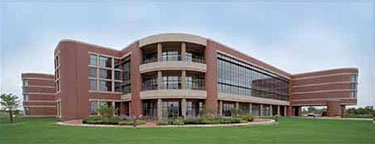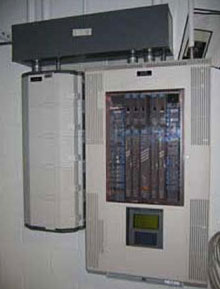Environmental awareness and sustainability are far from new concepts at the SC Johnson family of companies, which includes JohnsonDiversey, Inc. (JDI), a commercial cleaning and hygiene products company. So, in 1997 when JDI headquarters was built, in Sturtevant, Wisconsin, guidelines stipulated that the building be both "a great place to work" and "environmentally responsible." 1 The project team was also challenged to deliver a cost competitive project. The result is a truly innovative and inspiring building that makes extensive use of advanced monitoring and control systems, energy efficiency and natural lighting. In the process, it takes great advantage of copper's many benefits.
This study focuses on JDI's renovation efforts and its pursuit of LEED for existing buildings (LEED-EB). According to Greg Bell, director of Global External Communication for JDI, there is a distinction between how decisions are made for new construction and for renovations. When building from the ground up, he says, you can think about new ideas and features, which can act as systems or fit into a bigger picture, constrained only by budget. In contrast, for renovations, you must present the business case for each change, showing how each improves the bottom line.

JDI Headquarters, Racine, Wisconsin
Photo courtesy of USGBC
For example, you can predict with reasonable accuracy the energy savings associated with improving a building's insulation. However, features such as a central atrium and light shelving designed to feed natural light deep into the building are not optional upgrades to an existing building; whereas, improved monitoring and automatic lighting are.
| Building Floor Space, ft 2 | 277,440 |
| Initial Implementation Cost | $73,800 |
| Initial Implementation Cost per ft 2 | $0.27 |
| Annual Net Savings | $137,320 |
| Life-Cycle Net Present Value(15 years and 5% interest rate) | $1,351,535 |
| Return on Investment, years | 0.5 |
The Process
To initiate a sound decision-making process for existing buildings at JDI, Stu Carron, director of Global Facilities and Real Estate, wrote a white paper explaining the USGBC and LEED-EB. Senior management supported the process completely. Consultants, who identified "the most achievable and cost-effective opportunities for change" and listed recommendations for achieving LEED-EB prerequisites and credits, were engaged." 3
Carron then established a project team and assigned responsibility for each of the LEED categories. They identified "Green Starting Points," which are either existing or easy-to-achieve practices. Their biggest challenge was to integrate the "business practices and systems" required by the LEED-EB program. 4
Monitoring and Control Systems

Part of the JDI monitoring and control system
Photo courtesy of USGBC
The renovated building uses a Johnson Controls Metasys® system to monitor and control all of the building's HVAC equipment. It continually monitors temperature, humidity, lighting, electricity use, water use, air volumes, static distribution, various equipment operations and CO2 levels. The system also allows for the setting of alarm parameters and the tracking of trends to highlight potential maintenance needs. 5 A series of sensors monitor CO2, temperature and humidity in the mixed air plenums of all major air handling systems, as well as in representative occupied spaces. 6
The extent of control in the system is demonstrated by personal environment modules (PEMs) installed in 93% of the building's office areas. The modules allow individuals to set a number of variables within their own workspace, tailoring it to their preferences. This includes lighting, temperature and even background noise. The PEMs automatically sense when a person is present, then turns on the lights and brings the air temperature to the set preference. It also automatically shuts off these features when the space is vacated.
This solution allows for slightly lower ambient temperatures and lighting in communal spaces and places additional heating and cooling close to the individual, making it more efficient. Background noise can be masked through the creation of white noise through speakers under each desk. These systems have been linked to improved performance and substantially fewer calls to facility operators for temperature changes. Temperature and light adjustments have also been installed in multi-occupant spaces such as meeting rooms. 7
Water
JDI generates substantial water savings through effective design and the use of various simple technologies. Outside the building, the use of potable water for irrigation is eliminated by capturing stormwater runoff in detention ponds in the natural wetlands that surround the facility. The runoff water is fed through an automatic sprinkler system linked to moisture sensors in the ground. And only property immediately surrounding the building was landscaped. 8
Inside, JDI installed automatic faucets with aerators that cut the amount of water coming through them from 2.5 gpm to 0.5 gpm. It also selected toilet and urinal fixtures that reduce water use to 1.6 gpf and 0.5 gpf, respectively. 9
Through these efforts, JDI achieves a baseline standard 32% below the fixture performance requirements of the Energy Policy Act of 1992. The change in the irrigation system alone, reduces potable water use by 24 million gallons. 10
Copper's Role
Where role does copper play in these efficient practices? Well, in practically every system in the building, copper is supporting or facilitating sustainability-from the copper plumbing in the restrooms to the extensive wiring needed to power the building and connect the control and monitoring systems. The table below shows where and how copper enabled JDI to achieve its LEED-EB certification.
| LEED EB Categories | Credit | Copper's Supporting Role | Why Copper? |
|---|---|---|---|
| Water Use Reduction | 3.1-3.2 | Piping, fixtures, wiring | Very durable, high recycled content, efficient electricity transmission |
| Building Operation & Maintenance: Building Systems Monitoring | 3.3 | Wiring | Most efficient viable wiring solution |
| Construction, Demolition and Renovation Waste Management | 1.1-1.2 | Easily recyclable | Is one of the most easily recycled building materials available |
| Optimize Use of Alternative Material | 2.1-2.5 | High recycled content, local suppliers | Exceptionally high recycled content and often available from local suppliers, reducing its embedded energy |
| Controllability of Systems: Lighting, Temperature & Ventilation | 6.1-6.2 | Wiring | Most efficient viable wiring solution |
| Thermal Comfort: Permanent Monitoring System | 7.2 |
Conclusion
In 1935, H.F. Johnson traveled to Brazil to study the sustainability of Carnauba palms that were used in the company's products, thus establishing a tradition of pursuing sustainability and taking a leadership position in that arena. 11 In its headquarters, JDI continues this tradition, in both the original construction and renovation. Using copper throughout this building materially contributes to the company's continual pursuit of sustainable business practices.
Footnotes
-
 Interview with Greg Bell, Director, Global External Communication, JohnsonDiversey, March 2007.
Interview with Greg Bell, Director, Global External Communication, JohnsonDiversey, March 2007. -
 USGBC LEED-EB Project Case Study: JohnsonDiversey Headquarters, October 2004, pg. 7.
USGBC LEED-EB Project Case Study: JohnsonDiversey Headquarters, October 2004, pg. 7. -
 USGBC LEED-EB Project Case Study: JohnsonDiversey Headquarters, October 2004 , pg. 6.
USGBC LEED-EB Project Case Study: JohnsonDiversey Headquarters, October 2004 , pg. 6. -
 USGBC LEED-EB Project Case Study: JohnsonDiversey Headquarters, October 2004, pg. 5-7.
USGBC LEED-EB Project Case Study: JohnsonDiversey Headquarters, October 2004, pg. 5-7. -
 Interview with Greg Bell, Director, Global External Communication, JohnsonDiversey, March 2007.
Interview with Greg Bell, Director, Global External Communication, JohnsonDiversey, March 2007. -
 USGBC LEED-EB Project Case Study: JohnsonDiversey Headquarters, October 2004, pg. 38.
USGBC LEED-EB Project Case Study: JohnsonDiversey Headquarters, October 2004, pg. 38. -
 USGBC LEED-EB Project Case Study: JohnsonDiversey Headquarters, October 2004, pg. 43.
USGBC LEED-EB Project Case Study: JohnsonDiversey Headquarters, October 2004, pg. 43. -
 Interview with Greg Bell, Director, Global External Communication, JohnsonDiversey, March 2007.
Interview with Greg Bell, Director, Global External Communication, JohnsonDiversey, March 2007. -
 USGBC LEED-EB Project Case Study: JohnsonDiversey Headquarters, October 2004, pg. 19, 22.
USGBC LEED-EB Project Case Study: JohnsonDiversey Headquarters, October 2004, pg. 19, 22. -
 USGBC LEED-EB Project Case Study: JohnsonDiversey Headquarters,October 2004, pg. 21.
USGBC LEED-EB Project Case Study: JohnsonDiversey Headquarters,October 2004, pg. 21. -
 JohnsonDiversey Website
JohnsonDiversey Website
Notes
The USGBC LEED-EB Project Case Study: JohnsonDiversey Headquarters, October 2004.
